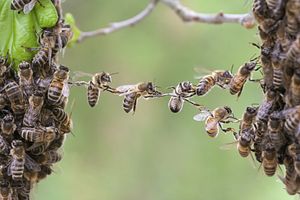Mass bee die-offs threaten food security around the world, but a global big data initiative led by the Australian Commonwealth Science and Industrial Research Organisation is microchipping bees in the hope of discovering some of the causes of these yet-unexplained deaths.
Putting a microchip on a bee does not sound like the easiest thing, but according to physicist Dr. Paulo de Souza of the Commonwealth Scientific and Industrial Research Organisation (CSIRO) in Australia it is a simple operation and very quick. This can only be a good thing, given that the Global Initiative for Honeybee Health plans to have one million bees, honey and otherwise, chipped by the end of next year. At the time of writing, some 50,000 have been chipped.
These chips, attached to the bee’s back and apparently weighing around a third of what a honey bee can carry at a full load, record its movements like a little “black box,” and transmit information to a small processor near the hive. Though this is a global project with more than 60 scientists in Africa, the Amazon, Europe, the U.K., and the U.S., it is being led by the CSIRO thanks to the organization’s broad research capabilities and ability to manage scientists from entomologists and plant scientists to big data analysts and physicists. The project is being run out of the CSIRO’s Hobart location, in Tasmania.
What does chipping one million bees with tiny computers achieve? There has been a global bee die off in recent years, and no one really knows why. There are plenty of theories but none one could rightly term a scientific theory. Is it the neonicotinoids in pesticides? Climate change? Pests like the tiny parasitic Varroa mite (thankfully not present in Australia) or Africanized bees attacking the more gentle European honeybees that pollinate a good portion of crops worldwide?
And this is the problem. Both domestic and wild bees pollinate a good portion of the world’s crops and both are subject to colony collapse disorder (CCD), a problem where all adult bees disappear from a hive, leaving behind a queen and juveniles. Colony collapse is often conflated with all bee die-offs but it is actually only one of several threats that include bees actually dying in large numbers (not simply disappearing from a hive) and queens not living as long. Honeybees, and some other kinds of bee, do not pollinate all crops, and not starchy staples, but they are needed in varying degrees for fruit and vegetables (crops such as almonds are entirely reliant on pollination). In Australia wild bees still pollinate most crops and a large die off (Australia does not suffer from CCD) would mean that managed hives would need to be used, significantly driving up the cost of certain foods now considered basics.
The GIHH plan is an ambitious one, but elegant in that shared data protocols between all scientists across the planet mean that all information can easily be shared and aggregated, even if the sheer amount of data is barely comprehensible to a person. Two hundred bees in an average hive are tagged and each bee makes numerous trips each day.
When a bee becomes stressed its habits and movements change. By subjecting bees to different stressors, such as different levels of a kind of pesticide (and keeping one hive pesticide-free as a control) it’s hoped a picture will emerge of how and why hives are dying off.
Past studies have been necessarily specific: this much of this type of pesticide administered for this much time. Speaking with The Diplomat, de Souza said that this is “very minute detail that does not allow us to see the big picture.” Through this global initiative they will be able to put a series of pieces or pictures together to “determine which pieces of the puzzle are still missing (after this) then design solutions for the problem.” In scientific terms it is, possibly, a compound cause and there will likely be no single Eureka moment to unlock the secret.
de Souza compares the project to global climate change work – the hardware and data protocols are not necessarily the same worldwide, but it is scientists across the world working on a problem that will affect the planet. Just as computer scientists have begun to use ant colonies to model computer intelligence and manage data, now big data methods are being put into service to manage bees, in the hope of saving them before it is too late.

































